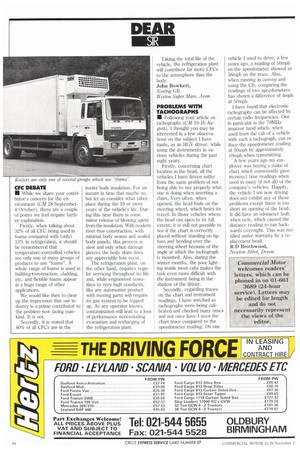CFC DEBATE • While we share your contributor's concern for
Page 66

If you've noticed an error in this article please click here to report it so we can fix it.
the environment (CM 28 September4 October), there are a couple of points we feel require further explanation.
Firstly, when talking about 32% of all CFC being used in foams compared with (only) 13% in refrigeration, it should be remembered that temperature-controlled vehicles are only one of many groups of products to use "foams". A whole range of foams is used in building tonstruction, cladding, etc, and flexible foams appear in a huge range of other applications.
We would like then to clear up the impression that our industry is a prime contributor to the problem now facing mankind. It is not.
Secondly, it is stated that 80% of all CFCs are in the reefer body insulation. For an instant in time that maybe so, but let us consider what takes place during the 10 or more years of the vehicle's life. During this time there is some minor release of blowing agent from the insulation. With modern rivet-free construction, with minimal body seams and sealed body panels, this process is slow and only when damage pierces the body skins does any appreciable loss occur.
The refrigeration plant, on the other hand, requires regular servicing throughout its life and, while engineered nowadays to very high standards, like any automotive product with moving parts will require its gas system to be topped up. As any operator knows, contamination will lead to a loss of performance necessitating evacuation and recharging of the refrigeration plant. Taking the total life of the vehicle, the refrigeration plant will contribute far more CFCs to the atmosphere than the body.
John Bowkett, Norfrig GB,
Weston Super Mare„4 von.
PROBLEMS WITH TACHOGRAPHS
Following your article on tachographs (CM 10-16 August), I thought you may be interested in a few observations on the subject I have made, as an HGV driver, while using the instruments in various vehicles during the past eight years.
Firstly, concerning chart location in the head, all the vehicles I have driven suffer from the same problem of not being able to see properly what one is doing when inserting a chart. Very often, when opened, the head fouls on the steering wheel, which limits its travel. In those vehicles where the head can open to its full extent, it is still not possible to see if the chart is correctly placed without standing on tiptoes and bending over the steering wheel because of the angle at which the tachograph is mounted. Also, during the winter months, the poor lighting inside most cabs makes the task even more difficult with the instrument being in the shadow of the driver.
Secondly, regarding traces on the chart and instrument readings, I have watched as tachographs were being calibrated and checked many times and not once have I seen the chart trace compared to the speedometer reading. On one vehicle I used to drive, a few years ago, a reading of 50mph on the speedometer showed as 56mph on the trace. Also, when running in convoy and using the CB, comparing the readings of two speedometers has shown a difference of 4mph at 50mph.
I have found that electronic tachographs can be affected by certain radio frequencies. One in particular is the 70MHz amateur band which, when used from the cab of a vehicle with such a tachograph, can reduce the speedometer reading at 50mph by approximately lOmph when transmitting.
A few years ago my employer was buying a make of chart which consistently gave incorrect time readings when used in many (if not all) of the company's vehicles. Happily, the vehicle I am now driving does not exhibit any of these problems except there is too short an opening of the head. It did have an odometer fault, when new, which caused the distance reading to run backwards overnight. This was rectified under warranty by a replacement head.
R D Brothwood,
Newton Abbot, Devon.
Commercial Motor welcomes readers' letters, which can be phoned in on 01-661 3689 (24-hour service). Letters may be edited for length and do not necessarily represent the views of the editor.




































































































































































